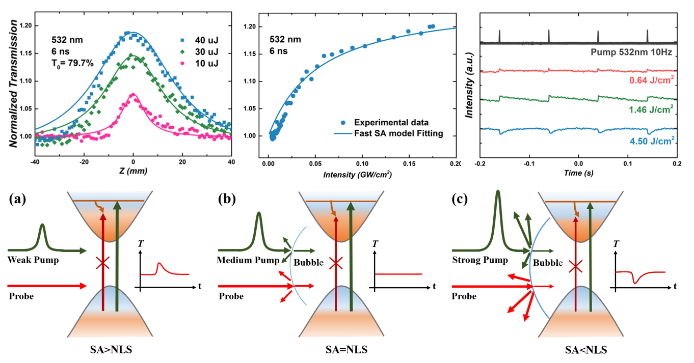Intriguing optical properties can emerge in diverse two-dimensional (2D) nanomaterials when thinning down to their layer limits; and few-layer black phosphorus (BP) exhibits unique properties, such as high charge-carrier mobility, large current on/off ratios, strong anisotropy in heat or electric conducting, and a broadband nonlinear optical response, endowing it with potential applications in field-effect transistors, optical limiters, mode-locked and Q-switched lasers, as well as optical modulators.
Optical modulators that can control absorption and/or refraction of 2D materials through another light beam have drawn heightened attention due to the increasing demand of advanced photonic and optoelectronic devices. However, the optical modulation behavior of BP has been rarely reported to date. To this end, the first thing is to investigate the nonlinar optical (NLO) properties of BP and clearly understand the nonlinear mechanisms.
Recently, a collaborative stduy led by Prof. Dr. Wang Jun at Key laboratory of Materials for High-Power Laser, Shanghai Institute of Optics and Fine Mechanics, Chinese Academy of Sciences, reported the NLO properties and optical modulation behavior of BP nanosheets dispersions.
They investigated the wavelength- and pulse duration-dependent saturable absorption (SA) property of BP at a fs pulse laser of 1030 nm/515 nm and a ns pulse laser of 1064 nm/532 nm. The results showed that BP exhibits a better NLO response in the visible range than that in the near-infrared range and stronger SA ability in 6 ns pulse excitation than that in 340 fs excitation. Tuning the excitation intensity, the 633 nm continuous wave (cw) can be effectively modulated by 532 nm pulsed laser into peaks (optically induced transparency) or valleys (optically induced extinction).
Researchers proposed that the optically induced transparency and optical limiting properties of BP dispersions mainly originate from the competition between SA and nonlinear scattering. This work have demonstrated BP nanosheets as potential candidates for optical modulators.
This study, entitled “Nonlinear Absorption Induced Transparency and Optical Limiting of Black Phosphorus Nanosheets” was published on ACS Photonics 4, 3063-3070 (2017).
This work was supported by the Chinese National Natural Science Foundation, the Strategic Priority Research Program of CAS, the Key Research Program of Frontier Science of CAS, and the Program of Shanghai Academic Research Leader.
Related website:
http://pubs.acs.org/doi/10.1021/acsphotonics.7b00598

Top: Nonlinear optical response and optical modulation results of BP dispersions.
Bottom: Mechanisms of competition between SA and NLS.
(Image by Dr. Wang’s lab)







